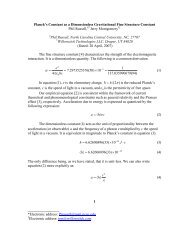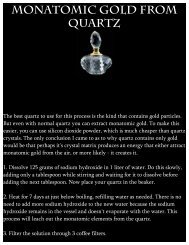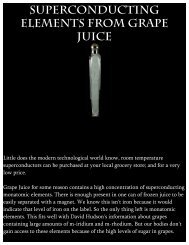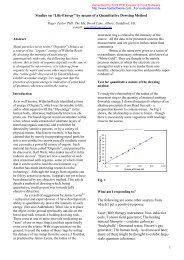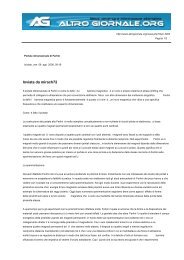Viktor Schauberger
Viktor Schauberger
Viktor Schauberger
You also want an ePaper? Increase the reach of your titles
YUMPU automatically turns print PDFs into web optimized ePapers that Google loves.
In principle the "other side flying machine" should create an extremely strong field<br />
around itself extending somewhat into its surroundings which would render the space<br />
thus enclosed including the machine a microcosm absolutely independent of the<br />
earthbound space. At maximum strength this field would be independent of all<br />
surrounding universal forces - like gravitation, electromaguetism, radiation and matter<br />
of any kind - and could therefore manoeuvre within the gravitational or any other field<br />
at will, without the acceleration forces being effective or perceptible.<br />
In June 1934 VIKTOR SCHAUBERGER was invited by HITLER and the highest<br />
representatives of the Thule and Vril societies and from then on worked with them.<br />
After the initial failure the first so-called German UFO also came out in June 1934.<br />
Under the leadership of Dr. W. 0. Schumann the first experimental round flying<br />
machine, the RFZ 1 (Rundflugzeug 1) was developed on the grounds of the aircraft<br />
factory Arado in Brandenburg. In its first and only flight it rose vertically to around 60<br />
metres, then wobbled and danced in the air for minutes. The Arado 196 guiding<br />
system was utterly useless. The pilot Lothar Waiz just managed somehow to bring it<br />
down to the ground, jump out and run away before it began to act like a spinning top,<br />
turned over and literally ripped to pieces. That was the end of the RFZ 1, but the<br />
beginning of the VRIL flying machines.<br />
Before the end of 1934 the RFZ 2 was ready, with a Vril drive and a "magnetic field<br />
impulse steering unit". It had a diameter of five metres and the following flying<br />
characteristics: With rising speed the visible contours became blurred and the craft<br />
showed the colours typical for UFOs: depending on the drive setting red, orange,<br />
yellow, green, white, blue or purple. It worked - and it should meet a remarkable<br />
destiny in 1941, during the "Battle of Britain", when it was used as transatlantic<br />
reconnaissance craft, because for these flights the German standard fighters ME 109<br />
had an insufficient range.



